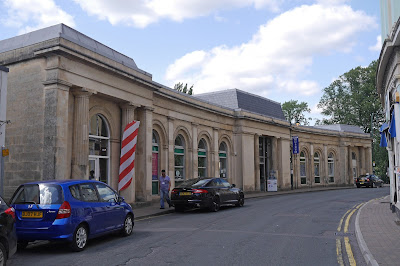Shire Hall, Monmouth
This post describes a walk around the delightful town of Monmouth. Between 1974 and 1996 Monmouthshire was part of the new county of Gwent, but now it is a county again in its own right. There was once some historical ambiguity about whether Monmouthshire was in England or Wales, but it is now definitely part of Wales. Our visit to Monmouth was with Ange's brother Ric and his wife Gabriella who are over from Canada on a visit.
We collected a leaflet describing the town's Blue Plaque Heritage Walk from the tourist office in Shire Hall and set off from there. Shire Hall is a most harmonious building of 1724 which was originally built as a combined assize court and market house. The celebrated Chartist Trials took place there in 1839. The statue on the facade is of Henry V, who was born in Monmouth, and was added in 1792. The statue in front of the building is of Charles Rolls (of Rolls Royce fame).
We crossed Agincourt Square and walked up Castle Street. On the left was Castle House with a fine Queen Anne doorway, while on the right is Great Castle House, an imposing structure of 1673. It is now the HQ of the Royal Monmouthshire Military Engineers.
More of less opposite Great Castle House are the remains of the original castle which dates from the 11th century.
Returning to the bottom of Castle St we turned left into Priory St. This is a very early example of a by-pass, being constructed in 1837 to route traffic away from the narrow Church St, until the main thoroughfare through the town. It the work of local architect G V Maddox.
On the left is what remains of Maddox's Market Hall. This once had two storeys with a cupola in the centre, but was largely destroyed by a fire in 1963. The building was saved from complete demolition by the casting vote of the mayor, but funds only allowed the rebuilding of the ground floor facade. The building now houses the Nelson Museum.
We were very struck by the view out of town from just beside the museum: below us was the River Monnow, from which the town takes its name and beyond it was open country.
Passing the church on the right (which we will come back to) we reached the Priory. Founded in 1080 by the Benedictines and dissolved by Henry VIII, it became a school in the 18th century and a Youth Hostel from 1971. The oriel window is know as Geoffrey's Window (after the historian Geoffrey of Monmouth, even though it was built 300 years after his death). Pevsner describes it as "sumptious" The three sandstone heads under the window represent The Knight, The Angel and The Miller.
At the end of Priory St we turned left briefly into Monk Street to see the Masonic Hall which was also the work of Maddox.
Then we followed Monk St in the opposite direction to reach the Rolls Hall which was presented to the people of Monmouth by John Allan Rolls to commemorate Queen Victoria's Jubilee in 1887. The architect was F A Powell. It is now a library.
Further along Whitecross St you come into the pretty St James Square, with a lovely war memorial of 1923. There are a couple of fine 18th century houses here too. I was also struck by another view out of the town towards green hills.
We turned into St James St and soon discovered that the impressive pinnacles and gables we could see ahead belonged to Monmouth School, originally built in 1625.
We now turned into St Mary's St to find St Mary's Roman Catholic church on the right. The penal laws against Catholics were relaxed only in 1778 and this church was an early example of new Catholic churches built thereafter. Permission was only given on condition that the church not look like one and not open onto the highway.
The original chapel was built behind some houses and was only extended forwards to its present appearance in 1871.
Following this street to its end brought us to Church St and the entrance to St Mary's church, looking very appealing in the afternoon sun. The church dates back to 1101, and was rebuilt in 1736-7, but the present building was mostly constructed in 1882 by G E Street, retaining some Norman remains and the 14th century tower. Inside it is wide and spacious, with stained glass by Kempe.
Now we returned to Agincourt Square and walked down Monnow St towards the famous Monnow Bridge. Just before we reached it I took this view along the river with more hills beyond.
Monnow Bridge is a remarkable survival of a medieval bridge with a gate tower on the bridge. It was built in 1270, at the same time as the long-demolished town walls, and altered in the 18th and 19th centuries.
Conditions: waerm and sunny.
Distance: only a couple of miles. We missed out one or two elements of the offical town trail.
Rating: four stars.














No comments:
Post a Comment